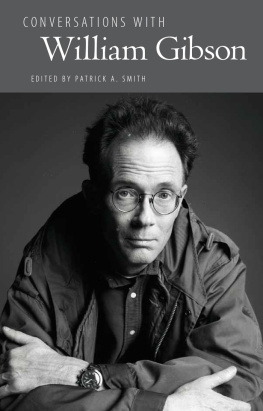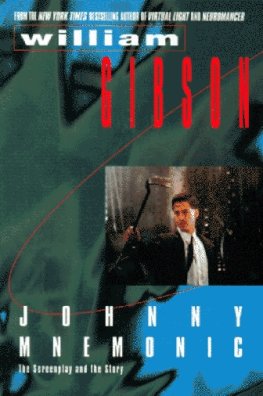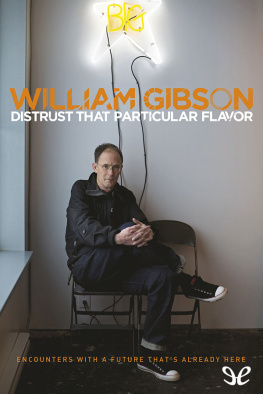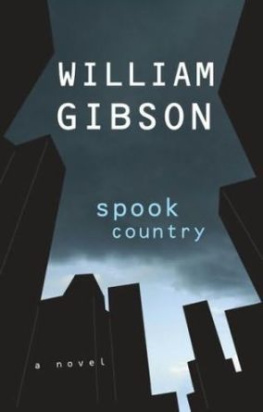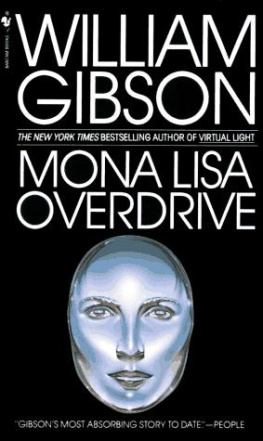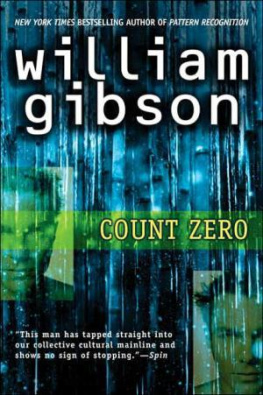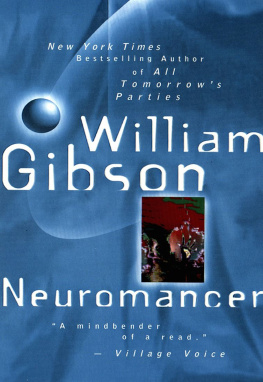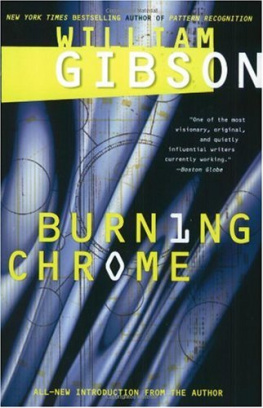Conversations with William Gibson
Literary Conversations Series
Peggy Whitman Prenshaw
General Editor
Conversations
with William Gibson
Edited by Patrick A. Smith
University Press of Mississippi Jackson
Books by William Gibson
Neuromancer. New York: Ace, 1984.
Burning Chrome. New York: Ace, 1986.
Count Zero. New York: Ace, 1986.
Mona Lisa Overdrive. New York: Ace, 1988.
The Difference Engine. New York: Bantam, 1990.
Virtual Light. New York: Bantam Spectra, 1993.
Idoru. New York: Berkley, 1996.
All Tomorrows Parties. New York: Ace, 1999.
Pattern Recognition. New York: Putnam, 2003.
Spook Country. New York: Putnam, 2007.
Zero History. New York: Putnam, 2010.
Distrust That Particular Flavor. New York: Putnam, 2012.
www.upress.state.ms.us
The University Press of Mississippi is a member of the Association of American University Presses.
Copyright 2014 by University Press of Mississippi
All rights reserved
Manufactured in the United States of America
First printing 2014
Library of Congress Cataloging-in-Publication Data
Conversations with William Gibson / edited by Patrick A. Smith.
pages cm. (Literary conversations series)
Includes index.
ISBN 978-1-62846-015-5 (cloth : alk. paper) ISBN 978-1-62846-016-2 (ebook) 1. Gibson, William, 1948Interviews. 2. Novelists, American20th centuryInterviews. I. Smith, Patrick A., 1967 editor of compilation.
PS3557.I2264Z645 2014
813.54dc23
[B]
2013030504
British Library Cataloging-in-Publication Data available
the ear of space
hand and embrace.
subvention by
Figure Foundation
Contents
Takayuki Tatsumi / 1986
Larry McCaffery / 1986
Timothy Leary / 1989
Darren Wershler-Henry / 1989
Daniel Fischlin, Veronica Hollinger, and Andrew Taylor / 1991
Andy Diggle and Iain Ball / 1993
Giuseppe Salza / 1994
Scott Rosenberg / 1994
Scott Rosenberg / 1996
Andy Diggle / 1997
Edo van Belkom / 1997
Jon Courtenay Grimwood / 1998
Antony Johnston / 1999
Cory Doctorow / 1999
Donna McMahon / 2003
Alex Dueben / 2007
Mary Ann Gwinn / 2007
Tim Adams / 2007
Noel Murray / 2007
Annalee Newitz / 2008
David Wallace-Wells / 2011
John Joseph Adams and David Barr Kirtley / 2012
Charlie Jane Anders / 2012
Introduction
Cyberpunk is a sort of saprophyte that piggy-backs on the main stem of SF, William Gibson tells Andy Diggle in a 1993 interview, nearly a decade after the stunning success of Gibsons debut novel, Neuromancer (1984), transformed both the author and a lexical lightning strikehis notion of cyberspaceinto a mainstream phenomenon. But every fifth interviewer comes in and says, Well, how does it feel to have changed the face of science fiction? And unfortunately if you look at its face, its pretty much the same old face: bland and rather reactionary for the most part.
The interviews in this collection are drawn from a variety of media and sources: print and online journals and fanzines; academic journals; newspapers; blogs and podcasts; and the just plain Out There. This mix of interviews from both formal and popular sources approaches Gibson from different angles and provides a glimpse into the authors mindset at various times, from the grind of international book tours to the relative serenity of his home in Vancouver, British Columbia. Unsurprisingly, given the subject matter, many of the later interviews are conducted exclusively for the Internet. The subjects covered in these twenty-three conversations are myriad as well: Gibsons childhood in the American South and his early adulthood in Canada, with travel in Europe; his chafing against the traditional SF mold, the origins of cyberspace, and the unintended consequences (for both the author and society) of changing the way a culture thinks about technology; the writing process and the readers role in a new kind of fiction; branding and fashion; celebrity culture and social networking; the post-9/11 world; future uses of technology and the isolation and alienation engendered by new ways of solving old problems; overviews of his novels, short fiction, and nonfiction.
Over the years, the author has provided more than enough raw material for readers to gain a greater understanding of Gibson and his process than they might from reading the books and stories alone. The early interviews are a feeling-out processGibsons getting comfortable in the skin of the in-demand writerand sometimes collaborative, as in the several writers and editors who join Takayuki Tatsumi in the Disclave 86 interview, Darren Wershler-Henrys insightful joint interview with Gibson and SF writer and literary critic Tom Maddox, or any of several conversations featuring Gibson and Sterling. Those pieces, sometimes disjointed, their focus hazy, never fail to introduce additional facets of the author, allowing readers to triangulate their idea of Gibson with the reality (as it is) presented in these snapshots. Notwithstanding his occasional reluctance to take part in interviews, Gibson is authoritative and often effusive in his expression of the transcendent, transformative ideas that drive his fiction. Gibson remains steadfastly forward-looking in those pieces, more intent on examining technologys influence on culture than on his role in fostering the discussion.
The world in 1984, in the wake of the success of Neuromancer, must have seemed more than a little unreal for a Southern boy bored with the limited selections on the spinning mass-market-paperback racks in his local drug store and the dream, perhaps, of one day living a life where beautiful women actually can marry guys who look like Dr. Seuss characters. Instead of an exclusive focus on technology, the authors anthropological fascination with human societies and interactions finds ample expression in these interviews, from Takayukis incisive questioning on Gibsons relationship to gomi and Japanese culture in the authors work to perhaps the most in-depth conversation to date, a 2011 Paris Review interview in which the author provides a capstone to the first three decades of his career.
So much of Gibsons fiction centers on mediation and transgression, of the diminished importance of real interpersonal experience, and of the shrinking boundaries between human and machine consciousness and the apparent simultaneity of present, past, and future. The immediacy of the online formthe interview oddly cognizant of its own transience, perched somewhere between the permanence of print or the images on the screen and the ephemeral artifact subject to shifting URLs and the whims of a zeroes-and-ones virtualitycaptures the essence of Gibson in ways that more formal and unchanging conversation recorded in academic journals cannot. The pensive delivery, the recursive thoughts, the sly sense of humor (which, to the surprise of many readers, Gibson intends in his novels; the British think Im a humorist, he saysall are vital to glimpsing the mind of the maker and made more immediate by their medium of delivery.

